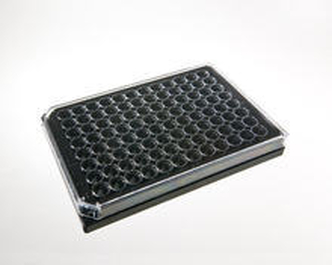PhenoPlate microplates for high content imaging applications are poly-D-lysine (PDL)-coated and are available in black in a 96-well format. These microplates benefit from a film bottom made of cyclic olefin, a plastic that has glass-like optical properties, providing superior image quality and also good cell adherence. They have an ultra-low plate bottom (0.2mm) for better well access when using water immersion and high NA objectives, and a new design, low profile polystyrene lid for reduced evaporation. Case of 40, 2 bags of 20.
Poly-lysine is a synthetic positively-charged polymer, existing as two enantiomers: Poly-D-lysine (PDL) and Poly-L-lysine (PLL). Adherence of certain cell types to poly-lysine-coated surfaces is based on the electrostatic interaction of the poly-D-lysine polycation with the negative charges of the cell membrane. Use of poly-lysine coatings on plate surfaces can help mediate the negative charges of the cell membrane and the negative charge of the surface. Both PDL and PLL are commonly used however PDL is not degraded by cellular proteases and is therefore often the preferred choice. As Poly-lysine is a synthetic protein, it does not influence the signaling pathways of the cells and is completely free of any animal contaminants. Almost all cell types will adhere to Poly-lysine coated plate bottoms.
Packaging Notes:
- Cases of 10 are packaged as 2 sleeves of 5 plates, lids included.
- Cases of 40 are packaged as 4 sleeves of 10 plates, lids included.
- Case of 50 is packaged as a case of individually packed lidded plates.
- Cases of 160 plates are packaged as 16 sleeves of 10 plates, lids included.
- Cases of 160 plates are packaged as 8 sleeves of 20 plates, lids included.




